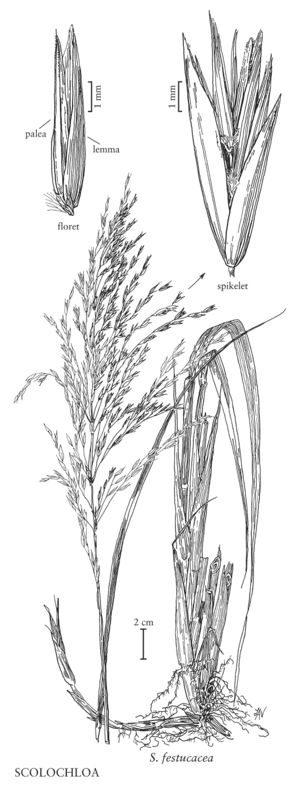| Taxon | Illustrator ⠉ | |
|---|---|---|
 | Scolochloa festucacea | Linda Ann Vorobik |
Plants perennial; strongly rhizomatous, rhizomes succulent. Culms 70-200 cm, sometimes rooting at the lower nodes. Sheaths open; auricles absent; ligules membranous, truncate to rounded; blades 4-12 mm wide, flat. Inflorescences terminal, open panicles, some branches longer than 1 cm. Spikelets pedicellate, laterally compressed, with 3-4 florets; rachillas prolonged beyond the base of the distal floret, internodes glabrous or with a few hairs to 0.2 mm long; disarticulation above the glumes, between the florets. Glumes unequal, acute to acuminate, unawned; lower glumes shorter than the adjacent lemma, 1-5-veined; upper glumes usually exceeding, sometimes equaling, the distal floret, 3-7-veined; calluses short, blunt, hairy; lemmas glabrous, rounded, 3-9-veined, veins excurrent, apices indistinctly 3-lobed or toothed, unawned; paleas about as long as the lemmas; lodicules free, glabrous; anthers 3; ovaries with pubescent apices. Caryopses shorter than the lemmas, concealed at maturity, about 2 mm, dorsiventrally compressed, x = 7.
Distribution
Mont., Wyo., Alaska, Minn., Oreg., Kans., Iowa, Alta., B.C., Man., N.W.T., Sask., Yukon, Idaho, N.Dak., Nebr., S.Dak.
Discussion
Scolochloa is a monospecific genus that grows in shallow water and marshes of the temperate regions of North America and Eurasia. In the Flora region, it grows primarily in the northern Great Plains and prairie pothole region, from British Columbia to Manitoba and south through Nebraska and Iowa, with disjunct populations in Alaska, eastern Oregon, Montana, Idaho, and Wyoming. Other outlying populations probably reflect introductions.
Selected References
Lower Taxa
"decumbent" is not a number.